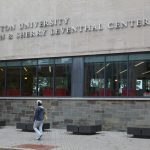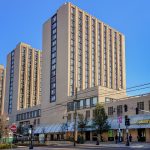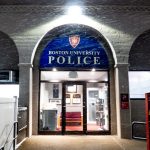A new study published by Boston University researchers showed BU’s COVID-19 policies were effective in preventing the spread of the disease when the University returned to in-person learning during the 2021 spring semester.

Ninety-one percent of COVID-19 cases never spread beyond one person, and less than 5% of cases never spread to more than three people, with only two exceptions where outbreaks of 40 and 47 people were recorded, according to the study.
The study was published on Oct. 19 by researchers working at the National Emerging Infectious Diseases Laboratories on BU’s Medical Campus.
Jacquelyn Turcinovic, a Ph.D. student at the Aram V. Chobanian & Edward Avedisian School of Medicine and first author of the study, said the researchers took a “quantitative approach” to measure the effectiveness of BU’s COVID-19 policies.
“We combined contact tracing data as well as viral genomics to quantify the number of times COVID was introduced to the campus populations from the community … and then also once it was in the BU population, to how many people did it spread,” she said.
Data was drawn from weekly mandated COVID-19 tests collected from students, staff and faculty. Contact tracers also worked to “actively monitor and investigate positive cases,” keeping track of close contacts, according to the study.
Researchers utilized genomic sequencing available at NEIDL, allowing them to keep track of individual COVID-19 cases by examining each new case’s genetic sequence.
“We had the unique opportunity to compare the qualitative information from the cases with the quantitative data of sequencing,” Hannah Lansberg, associate director of Student Health Services and co-author of the study, wrote in an email. “The genomic sequencing data helps to underscore the effectiveness of the University’s public health response to COVID-19 including testing, contact tracing, and isolation.”
BU’s preventative measures at the time included mandated weekly surveillance testing, social distancing and masking, and school-sanctioned social events were prohibited. People who tested positive were placed into isolation in on-campus housing or self-isolated in off-campus residence for up to 10 days.
Dr. David Hamer, a professor in the School of Public Health and MED, and a co-author of the study, said it was hard to point out which of the measures put in place by BU were the most important.
“I think it’s hard to separate [the measures] out and say, ‘well, we could have done with less of this or more of that,’” he said. “It’s hard because the most successful programs usually are multicomponent programs.”
However, he said that mask requirements in indoor areas, frequent testing and trying to limit large gatherings were some of the most important measures used by BU during the pandemic.
Hamer said the study was special because BU provided the researchers with resources and internal funding, noting that other universities did not do that or could not afford it.
“You can only do so much with contact tracing, but contact tracing is important to try and identify potential contacts,” Hamer said. “But ultimately, the quality of your evidence is stronger if you do actual sample collection and molecular analysis.”
Zack Furnari, a senior in the College of Communication, said he tested positive for COVID-19 and was placed into isolation housing in 2021.
“I applaud BU for removing people,” he said. “When I was in COVID housing, we were allowed 45 minutes outside a day, so that was tough, but it was only five days.”
Danny Nguyen, a junior in Questrom School of Business, said his first semester at BU was right after remote courses were no longer an option, and the measures seemed difficult for students to keep up with.
“They put in the policies of having to take a COVID test every single day,” Nguyen said. “There were many instances where everyone would forget to do their tests and then sometimes when you would go in, the testing site would be really crowded.”
Other students, like Wes Yan, a junior in the College of Engineering, believed that the measures were acceptable because it meant they got to attend class in person.
“I honestly thought the protocols were good,” Yan said. “It was nice that we were all able to attend class in person. That’s one of the reasons why I chose to go here instead of some other schools because all the classes were in person even though COVID was still going on.”
Ultimately, Turcinovic said practices such as staying home when sick and wearing a mask proved to be effective responses for future outbreaks, either of COVID-19 or of some other respiratory disease.
“I would hope that for the general person reading this study … you would read it and take away that, the things that we implemented then work, and they still work now and will continue to work in the future,” Turcinovic said.




